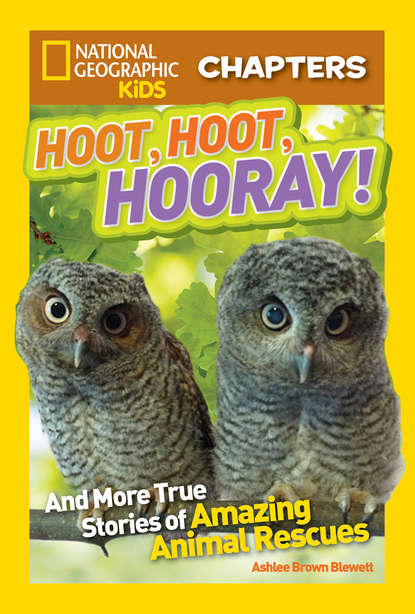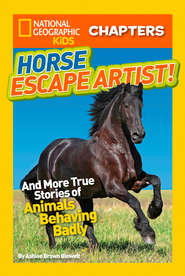По всем вопросам обращайтесь на: info@litportal.ru
(©) 2003-2024.
✖
National Geographic Kids Chapters: Hoot, Hoot, Hooray!: And More True Stories of Amazing Animal Rescues
Автор
Год написания книги
2019
Настройки чтения
Размер шрифта
Высота строк
Поля
Paul, on the top branch, looks ready to test his wings. Babe is not so sure. (photo credit 1.2 (#litres_trial_promo))
Finally, Mrs. Kuhn had an idea. She called the Maryland Department of Natural Resources, or DNR. They knew someone who could help! The next morning, Mrs. Kuhn drove the owlets to the DNR. Workers there helped get the babies to the Owl Moon Raptor Center in Boyds, Maryland, U.S.A. Raptors are birds of prey, such as eagles, hawks, and owls. They use their hooked beak and sharp talons (sounds like TAL-uns), or claws, to hunt other animals for food.
Suzanne Shoemaker runs Owl Moon out of her home. Her house sits in a patch of wooded land. Blue herons, ducks, and beavers live around a stream winding through the woods. Foxes slink across the grass.
Suzanne is a wildlife rehabilitator (sounds like ree-uh-BILL-uh-tay-ter). She has a special permit to care for hurt and orphaned raptors. She opened Owl Moon in 2002. She built two outdoor flight cages, called mews (sounds like MYOOZ), for the raptors. Once the birds are healthy, Suzanne keeps them in the mews until they are strong enough to be released back into the wild.
Suzanne turned one room of her basement into an indoor mew. She covered the windows with netting, so the birds could not fly into the glass or out an open window. And she put tree branches around the room to give the birds a natural place to perch, or stand. Suzanne wanted the mew to feel like the birds’ wild home.
Two adult screech-owls live in the indoor mew: Root’n Toot’n, a female, and Henry, a male. They play an important role at Owl Moon. They act as foster parents to baby owls that come to the center. Soon Root’n Toot’n and Henry would meet the new owlets. First, Suzanne needed to get the babies healthy.
As soon as the owlets arrived, Suzanne carried them down to the basement. She placed the owlets on a table. Then she looked them over from beak to claw. The owlets were a healthy weight. But something was wrong.
The babies had not coughed up pellets in two days. They had no energy, and they were dehydrated (sounds like dee-HYE-drate-id). This means that their bodies weren’t getting enough water. “Tammi Kuhn did the best she could caring for the owlets,” said Suzanne. “But they weren’t getting a good diet.” Now it was up to Suzanne to save them.
Suzanne sprang into action. She used a syringe (sounds like suh-RINJ) to inject fluid under the owlets’ skin. The fluid was like a clear sports drink for birds. This helped rehydrate them.
Next, Suzanne cut a dead mouse into small chunks. Suzanne calls this tasty bird treat “mouse mush.” It includes the meat, the bones, and the organs, too. The bones would help the owlets cough up pellets. Suzanne fed the babies mouse mush, using hemostats (sounds like HEE-muh-stats). Hemostats look like a pair of long, dull scissors.
Did You Know?
An eastern screech-owl can swallow a whole mouse in one gulp.
Finally, Suzanne put the babies inside an incubator (sounds like ING-kyuh-bay-tur). An incubator is a clear box. A fan pushes warm air inside the box. “At this point, the owlets needed to be kept warm, given fluids, and fed a proper diet,” Suzanne said.
Raising baby raptors is hard work. If you want to release them, it is important that the birds do not imprint on, or become attached to, humans. If a wild raptor thinks humans are friendly, it might try to approach them. This would put the bird and humans in danger. Imagine if a hawk crashed your picnic! To make sure the owlets did not imprint on her, Suzanne wore a special outfit called a ghillie (sounds like GILL-ee) suit. It looks like it is made of leaves or moss. The suit covers the entire body. It camouflages (sounds like KAM-uh-flazh-es), or hides, a human’s smell, too.
(photo credit 2.1 (#litres_trial_promo))
If Suzanne could get the owls healthy, she might be able to release them back into the wild. Over the years, Suzanne has cared for and released more than 500 birds. Normally, she re-nests owlets. She looks for a wild screech-owl nest with one or two babies inside it. She puts the orphaned owlet in the nest with them. Then she watches to see if the parent owls will adopt the new baby. Usually they do. If she can’t find a wild nest, Suzanne puts the baby owls inside a birdhouse. Then she places the birdhouse high up in a tree near other wild owls.
Вы ознакомились с фрагментом книги.
Приобретайте полный текст книги у нашего партнера:
Приобретайте полный текст книги у нашего партнера:






